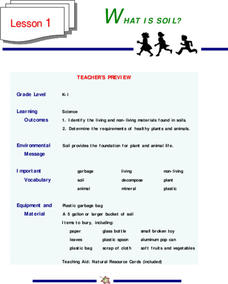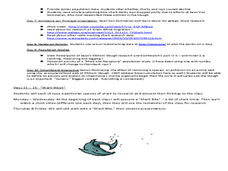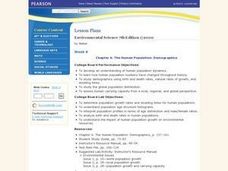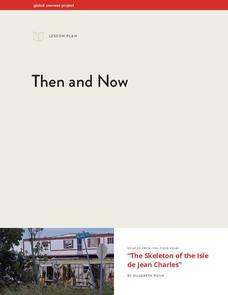Curated OER
Exploring Ecosystems
Students examine the relationships between plants, animals, and the environment in ecosystems. They sort animal cards, collect natural materials from the schoolyard, and record an ecosystem web in the form of a poster.
Curated OER
What in Our World Affects the Way People Live
Sixth graders study various maps that show geographical features and population. They compare the maps and make inferences about how various geographical features influence the population and human activities of an area.
Curated OER
Carbon Cycles
Pupils examine the carbon cycle and how carbon atoms travel through it. In this energy cycles lesson students describe how human activities affect the carbon cycle.
Curated OER
What is Soil?
Students study living and non-living materials that are found in soil. They study the things required by plants and animals to remain healthy. They design a collage of sand, stones, leaves and other natural items.
Curated OER
Waste Management
Four different activities focus on the amount of trash generated and how humans can better manage waste. Learners analyze two days' worth of household garbage, test materials for biodegradability, and rate recyclability of various...
Curated OER
Endangered Animals: Hawaii
Students locate regions in Hawaii where specific endangered animals live. They describe habitats, identify reasons why the species has become endangered, consider how a healthy environment for wildlife contributes to a healthy...
Curated OER
What Makes A Community Sustainable
In this environment activity, students read three different case studies in order to apply them to the categories of finding the best possible choices to make for helping a community flourish.
Curated OER
Carbon Footprint Estimator
Students discover what a Carbon Footprint represents. In this sustainable lifestyle lesson plan, students determine their Carbon Footprint as an individual and as a class. Students use a the Internet to calculate how many earths it would...
Curated OER
Water Quality Assessment
Students evaluate water quality of different sources. In this water assessment lesson students chemical testing, identify biological factors in the stream, and write a paper on their position of the stream's quality.
Curated OER
Hands Off
Students perform a handwashing experiment to see if a difference can be detected in the number and types of microbes on our hands after various types of cleaning. They will also demonstrate that they have learned the whys and hows of...
Curated OER
Understanding the Indoor Environment
Students create and deliver speeches about why their school should have an Indoor Air Quality team. In this speeches lesson plan, students make presentations to school board members about having an IAQ team.
Curated OER
Reducing Ecological Footprint Ads
Students examine the impact of geological footprints. In this geography skills lesson, students calculate geological footprints and discuss ways to reduce the footprints. Students create advertisements that motivate others to reduce...
Curated OER
Water and Sanitation
Learners examine water contamination problems. In this global studies lesson, students compare and contrast water sanitation issues on Malawi, Tanzania, and Ontario. Learners propose solutions to the water sanitation problems.
Curated OER
Go Fish! Exploring The Tragedy of the Commons
Learners discover what happens when people take advantage of shared resources. In this ecology instructional activity, students explore "The Tragedy of the Commons" by playing a role playing simulation game in small groups. Learners soon...
Curated OER
Populations in the Path of Natural Hazards
Learners read "Geographical Mobility: 1995-2000." They examine the maps in the handouts and compare them with maps from an atlas. In the second part of this instructional activity, students read "In Harm's Way." They receive three more...
Curated OER
Chapter 6: The Human Population: Demographics
Students read the indicated text and complete several suggested labs and activities. They answer critical thinking questions. This lesson is very hard to do without the indicated text.
Chicago Botanic Garden
Impacts of Climate Change
Scholars become experts on the eight major impacts of climate change through a jigsaw and grand conversation. They then research and present what they learned about effects specific to their region.
Chicago Botanic Garden
Faces of Climate Change
Sometimes, the best solution to a problem can be found by walking in someone else's shoes. Here, scholars use character cards to take on the roles of people around the world. They determine how their character's life affects our...
Population Connection
The Carbon Crunch
Carbon is in the air; should we care? Teach the class why it is important to pay attention to carbon levels and how the world population and various countries across the globe affect the carbon levels in the atmosphere. High schoolers...
Chicago Botanic Garden
Faces of Climate Change
How does climate change affect you? First in a three-part series, the activity focuses on how individuals living around the world are affected by climate change. Individuals take on the role of a given character and share their...
Population Connection
The Peopling of Our Planet
How many people live on the planet, anyway? The first resource in a six-part series covers the topic of the world population. Scholars work in groups to conduct research and make population posters after learning about the global...
Curated OER
Hazards: Fifth Grade Lesson Plans and Activities
After comparing earthquake and volcanic hazards to one another, fifth graders take a closer look at damage associated with a volcanic eruption. They then create a simulation of mudslides due to a volcanic eruption. Using different...
Rainforest Alliance
Forests of Guatemala
With 90 percent of its land area covered in forests, Suriname, a country in South America, contains the largest percentage of forests throughout the world. Here is an activity that brings classmates together to learn about the...
Global Oneness Project
Then and Now
The devastating changes happening to the Native American inhabitants of an island off the coast of Louisiana are the topic of an informational lesson. After scholars break into groups to explore particular topics, they come back together...

























